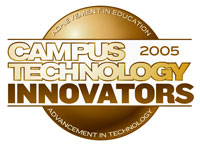CAMPUS TECHNOLOGY INNOVATORS 2005

IN THE NEVER-ENDING EFFORT to better serve students, faculty, and staff via technology, some college and university campuses take the kind of initiative—even out-and-out risk— that results in advances previously thought impossible, or at least, far down the pike.
The institutions we highlight here have pursued their technology challenges with the kind of doggedness that should serve as a model to other institutions wondering just how far they can push their own envelope. Whether it’s to advance foreign language learning through the use of digital technology; attract new students from previously untapped regions via superb Web portal services and customization; or improve the management, tracking, and security of chemical materials on the campus, the colleges and universities in this special feature have taken the initiative and followed through with people, process, and technology each step of the way. Most critical to the success of these initiatives are the vision and leadership of particular campus administrators, faculty, and staff. Equally important, in many cases, was the campus/vendor partnership forged to support the challenge and see it through. For those readers facing their own similar challenges, we say: Use these stories for inspiration, guidance, and even to make contact.

California State University's
Allison Jones
See link to his CSU story below.
Read all about the Innovators:
Defense Language Institute UNC CSU System Arizona State University University of Miami Case Western Reserve University Northeastern University Coppin State Web Exclusive: More Innovator Articles
Bryant UniversityCal Poly San Luis ObispoNew Jersey Institute of TechnologyHamilton CollegeMercyhurst College